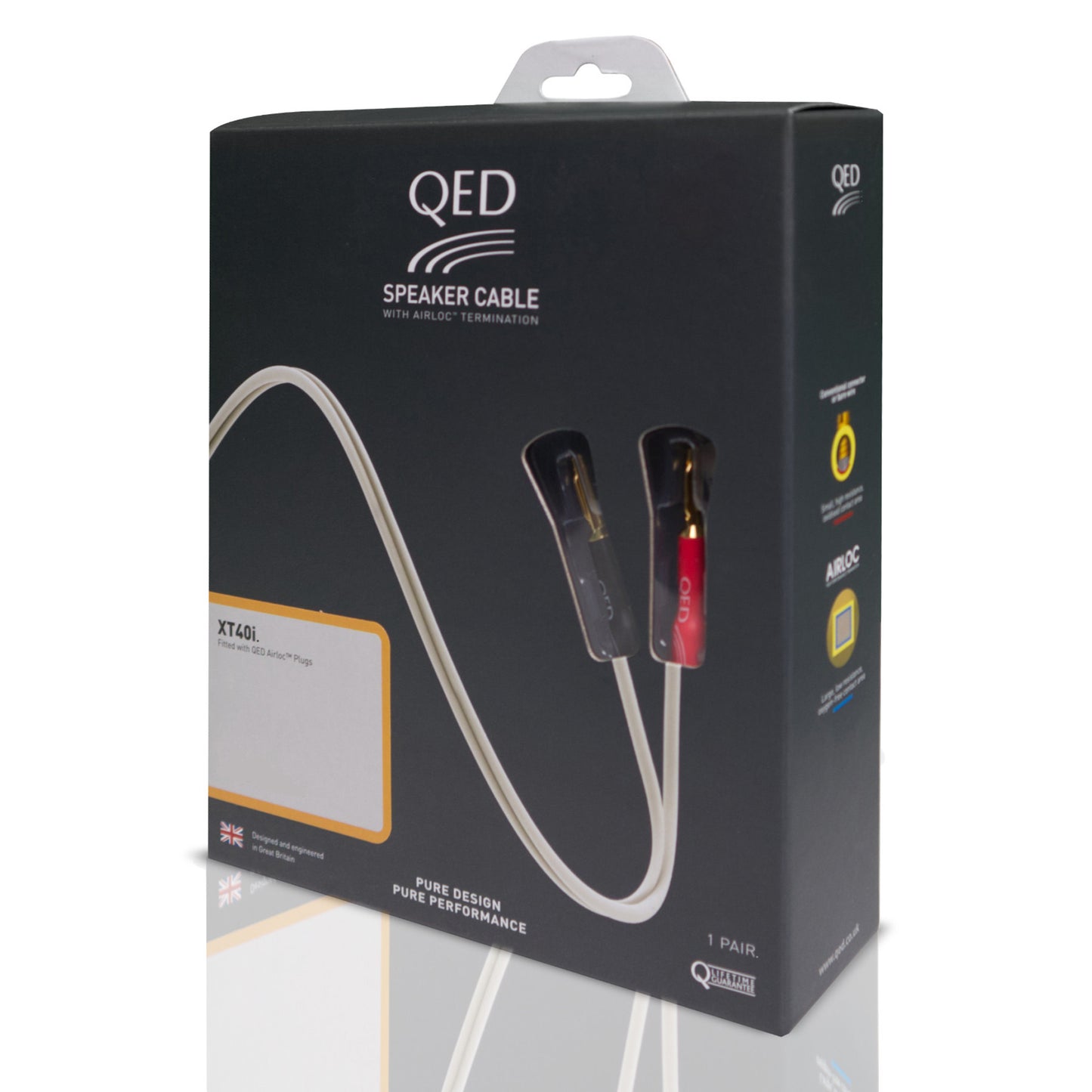





About QED Reference XT40i Terminated Speaker Cable
The QED Reference XT40i speaker cable takes the award winning XT40, released to celebrate QED's 40 Years of Award Winning British Heritage, and adds a brand new Air Gap dielectric to their well-established X-Tube technology to take performance to new heights, all at the same affordable price.
Acclaimed by What HI-FI? Magazine; this 'Five Star' award winning pure copper loudspeaker cable boasts QED's advanced X-Tube technology, brand new Air Gap dielectric and a massive 4mm cross sectional area. This results in a cable that delivers clear sonic advantages over conventional cable designs by maintaining a flat frequency response within the audio band.
As befits a company rapidly closing in on its fifth decade at the forefront of speaker cable design, QED's latest XT40i speaker cable builds on the formidable reputation of the XT40 cable it replaces and offers a decisive step up in sound quality.
This pure oxygen-free copper cable uses an evolution of QED's established X-Tube technology to guarantee superb timing and stereo imaging, and adds the brand new and highly innovative Air Gap dielectric to bring unheard-of rhythmic accuracy and musicality to a cable of this modest price. Very low DC resistance adds unrivalled frequency response to XT40i's already potent audio capability. The result is a cable that advances on the class-leading standards set by its predecessor.
Large Cross-Sectional Area: The 4mm2 cross sectional area means XT40i exhibits very low resistance, allowing amplifiers to exert outstanding control over the speakers they are driving. In addition, its large cross sectional area makes it suitable for long cable runs.
Air Gap Dielectric: By increasing the separation of the conductors inside the cable, and therefore the amount of air between them, QED has created a low-loss Air Gap dielectric. This technology halves the dissipation and capacitance characteristics of the cable, and results in numerous audible improvements - particularly where timing and rhythmic accuracy are concerned. Despite this increased separation, though, XT40i retains the sort of cross-sectional area that makes it ideal for long cable runs.
X-Tube Technology: Forming the cable conductors into a tube-like shape around a hollow insulating rod in the centre of the cable equalises current densities, delivers very low inductance and presents a consistent, even load to an amplifier. The result is a cable that retains more of the finest musical details, that handles rhythms and tempos in the most natural and musically satisfying way, and that outperforms rival designs costing far more.
At low frequencies both X-Tube and conventional stranded/solid core speaker cables convey signals in a linear way. However, at high frequencies, X-Tube retains a near-linear signal transfer, whereas the conventional cables fail to conduct uniformly across the entire conductor area.
In standard speaker cables at high frequencies current flow is highest at the periphery with rapidly deteriorating current density towards the centre of the conductor. The effect of this is to reduce the actual cross sectional area of the cable at 15kHz to less than 75% of that at low frequencies. This results in higher distortion and compromises the performance of the cable. X-Tube with polycore technology exhibits much lower self-inductance and is therefore less affected by this problem. The polycore technology reduces loop inductance to levels only achievable using more costly and difficult to terminate cables. So, with more high frequency detail, less distortion and greater performance, X-Tube delivers greater fidelity across the audio spectrum which would otherwise be lost in ordinary cables.
What is Airloc?
Airloc is a form of cold weld system that permanently attaches QED Forté banana plugs and spades to the entire range of QED and many other speaker cables. One of the main reasons for choosing a QED speaker cable is the superior d.c. resistance characteristics offered by their exclusive use of 99.999% OFC or oxygen free copper conductors. It isn't the smart thing to then go ruin all this attention to detail by neglecting the most vulnerable area of the speaker cable chain - that of the physical interface between cable and amplifier or speaker terminals. Since the mid 1970's there has been more co-operation between manufacturer's to allow for easier installation of good speaker cables and most products allow for use of both banana plugs and spade terminals. No, you don't have to use them, but they definitely have advantages over bare wire alone. Why?
Seen under a microscope the surface of a typical copper strand is very rough and so using normal screw type terminals - such as found on binding posts or cheap banana plugs - electrical contact is only made in a relatively small number of places. Add to this a layer of oxidation - which is inevitable if copper is exposed to the air for even a short time - and the combined resistance of the cable and its termination can creep back up to levels present in a more inferior cable.
By using a cold weld crimp type termination, QED Airloc Forté plugs squash the conductors and plug together to increase contact area and reduce resistance. By the time the full pressure has been applied the resistance of the joint has reached a minimum value.
Now, because all the air has been removed from the joint there will be no oxidisation of the contact surfaces so the low resistance will remain for the lifetime of the cable. During the cold weld process the cable and plug become one solid piece of metal. Since the copper contact has been effectively removed from the resistance equation we can concentrate on the plug to terminal resistance.
What are QED Forté Plugs?
The plugs themselves are made of solid brass which has roughly twice the resistivity of copper. For this reason the QED Forté 4mm banana plug was devised so that its cross-sectional area would be at least double that of the cable to which it was connected effectively cancelling out the extra resistance of the plug material. QED then plates the connector with high purity gold which has a resistivity almost as low as copper but more importantly does not oxidise in air. The relatively smooth gold surfaces provide a larger contact area than the uneven copper strands in the cable and because the gold will never oxidise the contact surface remains clean and low resistance for life.
The QED Forté plug pin section is designed to maximise contact area throughout the wide tolerance range encountered in 4mm amplifier and speaker sockets. Here some are quite tight whereas others are loose, so the spring loaded Forte blade is designed to fit into smaller and larger sockets with equal insertion force. This means that the contact area is maximised and the connection remains uniformly tight. QED Forté with Airloc technology is top-notch and delivers guaranteed low resistance and strength - for life.
The History Of QED
In 1973 Bob Abraham and Ian Vine founded QED Audio Products and changed the way people think about hi-fi cables. By the time QED 79 strand was launched in 1978, it wasn't considered' just another speaker cable' but a serious hi-fi component. During 1994 QED conducted the most extensive ever scientific investigation into the effects of speaker cable on hi-fi system performance. Read the results in "The Genesis Report". Hear the results whenever you listen to your favourite music using QED cables.
QED's reputation for innovation and technical excellence is known throughout the world. The latest computer-aided design techniques allow their research and development team to keep pace with technological advances and deliver products that achieve the highest levels of performance and reliability. This is why QED speaker cables are recommended by so many of the world's leading manufacturers of hi-fi and home theatre equipment. QED is Europe's number one award winning connectivity brand and has won more prestigious cable awards from 'What Hi-Fi? Sound & Vision' magazine than any other brand. - QED - The Sound Of Science
In the News
For anyone whose hi-fi is built upon clarity and analysis, these cables could be just the ticket. At times it is as if our system is begging for granular synthesizer pieces, something into which it can sink its teeth and taste each bold square and sawtooth wave as it passes over its palate. Or if not, then the creeping of a bow across the strings of a cello, or the excess air as it breezes through the mouthpiece of a tenor sax.
QED simply excels in helping hi-fi equipment describe the shape of an instrument, the room it is in and how its sound has been recorded, and the Reference XT40i in no way bucks that trend. It speaks about an improved sense of timing as well, and there is a definite eye for accuracy alongside attention to detail about the way our system performs with these cables plugged in. Nothing is allowed to slip, with notes and percussion hit with precision and intention. It isn't as though previous efforts have been altogether imprecise, but there is an unerring confidence about the way our speakers play here.
But it does offer us more of a musical whole. It is a lot to do with dynamic expression, those leading notes that turn accurate timing into a traceable rhythm, and which help portray a more lyrical, human bent to the music. It's also a little to do with organisation, and how each instrument is tethered to and interacts with one another – no doubt also aided by a little less space to play in.
In these regards, QED cannot really be beaten for the money. What Hi-Fi? 5 Star Review
Our Take On QED Reference XT40i Speaker Cable
XT40 won numerous awards when it was released back in 2014 and the new XT40i is set to once again define what is possible at the price point. The new XT40i has the sort of clarity and transparency that makes it easy to hear exactly what is going on in the depths of a musical soundscape in a relaxed and natural way meaning you don't have to try hard to enjoy your music, it just happens. Once you hear XT40i - we're confident you'll agree it even outperforms alternative cables at many times the price. Prepare to be surprised and delighted.
Main Features & Specifications
- Product Description: Factory terminated speaker cables fitted with QED Airloc Forté banana plugs
- Outside Diameter: 6 x 14 mm
- Conductor Area: 4 mm²
- Dielectric Properties: Air Gap (εr = 2.4)
- Conductor Chemistry: 99.999% oxygen-free copper
- Dielectric Properties: Air Gap
- Loop Resistance: 8.0 mΩ/m
- Parallel Capacitance: 35 pF/m
- Dissipation Factor @ 10kHz: 0.0295
- Self-Inductance: 0.57 μH/m
- Gauge: 12 AWG
- Available Lengths: 2 Metre, 3 Metre and 5 Metre terminated pairs
- Audio Trends also have custom lengths available - please enquire
- Manufacturer's Warranty: Lifetime
Note: Features & Specifications Subject To Change Without Notice. E&OE






